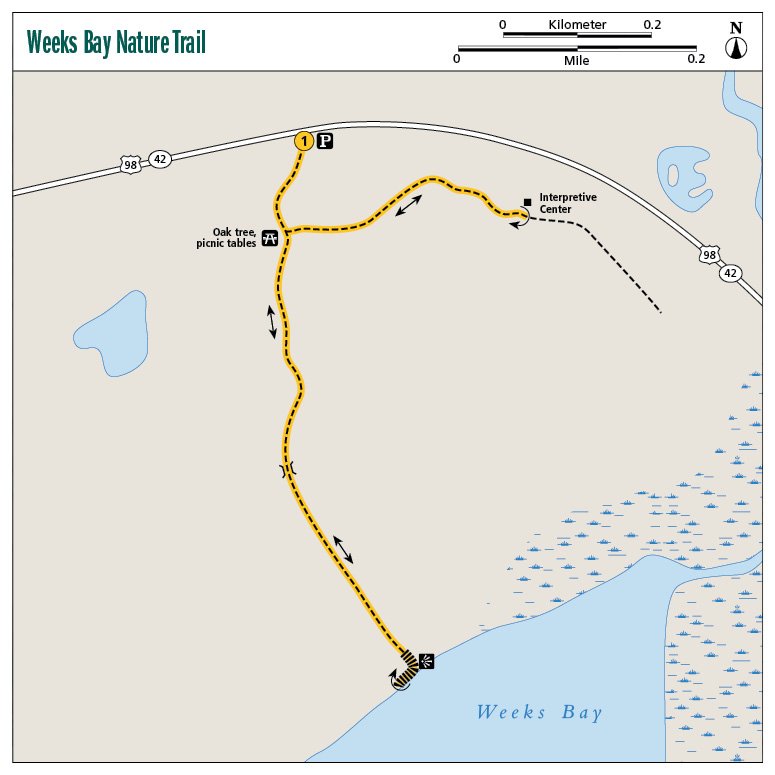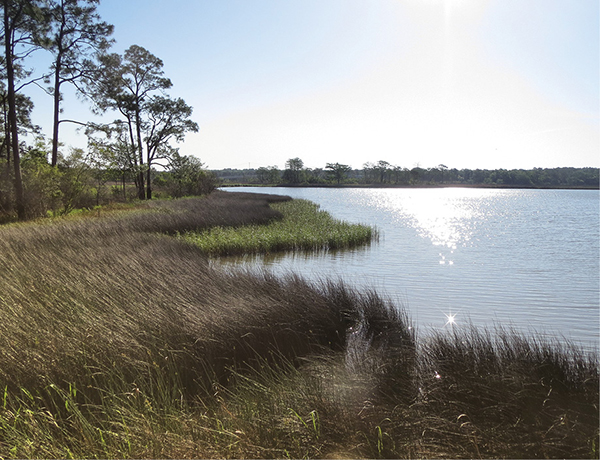
A beautiful live oak at the beginning of the Weeks Bay Nature Trail
1 Weeks Bay Nature Trail
This trail is a short and very easy walk around the Weeks Bay National Estuary. The estuary, home to a wide variety of birds and other plant and animal life, offers an interesting, enjoyable, and educational experience for all members of the family.
Start: Trailhead on US 98
Distance: 1.4 miles out and back
Hiking time: About 1 hour
Difficulty: Easy over flat paths and boardwalks
Trail surface: Dirt footpath, some boardwalk
Best seasons: Fall–spring
Other trail users: None
Canine compatibility: Leashed dogs permitted
Land status: National estuarine research reserve
Nearest town: Fairhope
Fees and permits: None
Schedule: Trail open year-round dawn to dusk; interpretive center open Mon–Sat 9 a.m.–5 p.m.
Maps: USGS Magnolia Springs, AL; DeLorme: Alabama Atlas & Gazetteer, page 63 G6; brochures available at trailhead kiosk
Trail contact: Weeks Bay National Estuarine Research Reserve, 11300 US 98, Fairhope, AL 36532; (251) 928-9792; www.outdooralabama.com/public-lands/statelands/weeksbay
Finding the trailhead: From Fairhope at the intersection of US 98 and Fairhope Avenue, take US 98 east 10.2 miles. The trailhead will be on the right. GPS: N30 25.214' / W87 50.080'
The Hike
This is not a high-tech, high-altitude, three-day backpacking trip. This short and simple nature path is included here for the purposes of spotlighting a beautiful reserve and an endangered habitat. If you have children, especially younger ones, this is a perfect opportunity to introduce them to hiking and exploring the great outdoors, and who knows, they just might learn something in the process.
The Weeks Bay National Estuarine Research Reserve is one of twenty-six such estuaries administered by the National Oceanic and Atmospheric Administration. By definition an estuary is a semi-enclosed body of water where freshwater from rivers mixes with saltwater from the ocean creating a brackish mix, a prime ingredient for supporting a wide variety of plant and animal life.
The Weeks Bay reserve was established in 1986 to protect land that was once at high risk of development. In fact, the county where the estuary is located, Baldwin, is one of the fastest-growing counties, if not the fastest-growing county, in the state. The reserve maintains for posterity 3,000 acres of marshland along Weeks and Mobile Bays and is fed by the Magnolia and Fish Rivers.
The reserve’s nature trail utilizes a combination of vegetation-friendly dirt paths to lead you through the forested swamps, along the banks of salt- and freshwater marshes, and through the tidal flats. Signs along the way identify animals and rare plants you may encounter (some of the information is provided in a brochure available at the trailhead kiosk or reserve office). Some of the trees you will see here include Japanese climbing fern, lots of loblolly pine, sweet gum, eastern red cedar, sweet pepperbush, and a variety of Myrica cerifera, a plant you know better as wax myrtle.
Among the animals that live here are blue crabs, red-bellied turtles, and American alligators. More than 350 species of birds are found at Weeks Bay, either permanently or during migration periods. Among them are the black needlerush, great blue heron, red-winged blackbird, and the once-endangered brown pelican. Plus there is a good contingency of bats here as well, including the brown bat and silver-haired bat.

A beautiful live oak at the beginning of the Weeks Bay Nature Trail
The trail we describe here begins at a large trailhead on US 98. It is a grass parking area with ample room for twenty-plus cars. For the most part the trail is a wide dirt footpath and is dry except after it rains, when it can be very muddy and boggy. If you plan on hiking the trail in the summer months, be sure to bring along a good dose of insect repellent. You are walking through marshes and bogs, after all. Some of the trail does have short “gangplanks” for you to navigate over when the trail is muddy. These are three 2-by-6 inch, 16-foot boards nailed together and placed in strategic locations for stepping on. The trail is marked with white wooden diamond-shaped markers with the letters WB on them in black.
About 400 feet from the trailhead, the path comes to a Y at a beautiful large live oak tree climbed by a resurrection fern. There is also a very nice wildflower patch with yellow colicroot, milkwort, and threadleaf sundew next to the tree and behind a fence. The blooms are exceptional in the spring. Take the right fork first and head south to Weeks Bay. There is a 200-foot boardwalk there with excellent views of the bay and marsh. At the end of the boardwalk, it looks like the trail continues but it doesn’t. It quickly dead-ends and you could find yourself standing in the marsh itself. Instead, turn around at the end of the boardwalk and head back to the Y.
Once at the Y, take the right fork and head east to the Weeks Bay Interpretive Center. Here you’ll find displays that describe the estuary and its plants and animals. At the back of the building there is a mini-zoo the kids will love (and you, too) with fish, blue crabs, and an alligator.
The Interpretive Center is the turnaround for this trip, where you will begin your walk back to the trailhead. Option: You can extend the trip an additional 0.3 mile along a nice boardwalk that takes you to another view of the bay and a dense wetland. The boardwalk begins on the left (east) side of the building. It was closed when I revisited the estuary, but from previous visits I can tell you it’s worth the trip.
While you’re in the neighborhood, be sure to head down to the Weeks Bay Pitcher Plant Bog. To get there from the estuary trailhead, take US 98 East over the Weeks Bay Bridge 1 mile, turn left onto CR 17, and follow the signs. The curious pitcher plant is a wily carnivore that feasts on insects. The Wintermeyer Nature Trail guides visitors easily through the bog, which, contrary to what you might think, is a relatively dry environment. The best time to visit the bog is in March and April when the plants are in full bloom.

Miles and Directions
|
0.0 |
Start from the trailhead on the south side of the parking lot. The path is a wide grass bed at this point with a wooden fence to your right (west). In 400 feet come to a large oak tree with resurrection fern. There are four picnic tables here and a garbage can. A nice wildflower patch is on the opposite side of the wooden fence to the west. Cross the dirt road to the east and come to a Y. A sign here shows the direction to the bay and interpretive center. Follow the sign by turning right (south) onto a narrow dirt footpath. |
|
0.2 |
Pass a large area of standing water (depending on rainfall) to your left (east). |
|
0.3 |
Cross a creek over a 15-foot bridge. After crossing, turn left (south) onto a dirt road (the turn to the right is blocked by a bench). |
|
0.5 |
Come to the boardwalk along the bay with a beautiful view and bench. You can walk about 200 feet on the boardwalk until it ends. Turn around here and retrace your steps to the Y at mile 0.0. (FYI: It looks like the trail continues at the end of the boardwalk to the west, but it doesn’t. It becomes impassable in a few feet.) |
|
1.0 |
Back at the Y, take the right fork (east) onto the very wide dirt path. In a few feet you will pass an obvious geocache. You will be walking parallel to US 98 through the hardwoods. |
|
1.1 |
The path is now a grass bed. |
|
1.2 |
Cross a dirt road to the east and come up behind the Interpretive Center. Stop in for a visit when they are open. This is your second turnaround point. Retrace your steps to the trailhead. (Option: Continue past the Interpretive Center and on the building’s east side there is another boardwalk that takes you to the bay and wetland and increases the trip by 0.3 mile.) |
|
1.4 |
Arrive back at the trailhead. |
Hiking Information
Local Information
Eastern Shore Chamber of Commerce, 327 Fairhope Ave., Fairhope, AL 36526; (251) 621-8001; www.eschamber.com
Local Events/Attractions
Fairhope Arts and Crafts Festival, 367 Fairhope Ave., Fairhope; (251) 621-8222; www.eschamber.com/artscrafts. For more than sixty years, the Fairhope Arts and Crafts Festival has been showcasing the work of the best local and national artisans. The event, held annually in mid-March, now boasts over 250 booths and, of course, lots of local food and music. There is no admission fee.
Restaurants
Pelican Patio / Church Street Chill Grill, 14 N. Church St., Fairhope; (251) 928-1714. Local seafood, burgers, and live music.
Other Resources
Weeks Bay Foundation, 11401 US 98, Fairhope, AL 36532; (251) 990-5004; www.weeksbay.org

The sun sparkles on the waters of Weeks Bay.